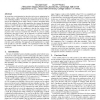Free Online Productivity Tools
i2Speak
i2Symbol
i2OCR
iTex2Img
iWeb2Print
iWeb2Shot
i2Type
iPdf2Split
iPdf2Merge
i2Bopomofo
i2Arabic
i2Style
i2Image
i2PDF
iLatex2Rtf
Sci2ools
ISCAS
2006
IEEE
2006
IEEE
Computing during supply voltage switching in DVS enabled real-time processors
In recent times, much attention has been devoted to power optimization for real-time systems, while guaranteeing that such systems meet their hard (or soft) scheduling deadlines. To reduce power, different tasks in such systems may be run at different power supply voltages, in order to maximally utilize slack in the schedule. However, prior approaches have ignored the practical aspects of switching the power supply. In a typical IC, the VDD net is highly capacitive, and as a result, its voltage cannot be changed instantaneously. In traditional approaches, the assumption is that this net switches instantaneously, which in effect makes it essential to include the VDD switching time in the worst-case execution time (WCET) of a process (adding pessimism to the WCET value). In our approach, we precisely model the switching of the VDD net, and allow the system to continue computations while VDD is being switched. The effect on the delay of tasks during this transition is precisely modeled. ...
| Added | 12 Jun 2010 |
| Updated | 12 Jun 2010 |
| Type | Conference |
| Year | 2006 |
| Where | ISCAS |
| Authors | Chunjie Duan, Sunil P. Khatri |
Comments (0)

